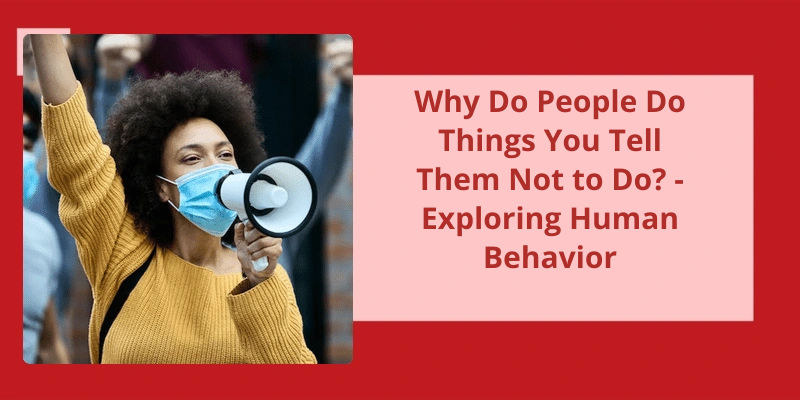Humans have a tendency to rebel against rules and regulations that restrict their freedom in any way. This is a common phenomenon observed across cultures and age groups. Even if we know that doing something is wrong or could have negative consequences, we may still be tempted to do it. In fact, we may be more likely to engage in such behavior if we’re explicitly told not to do so. This paradoxical response is often attributed to psychological reactance, a cognitive mechanism that seeks to protect our sense of autonomy and control. In this article, we will explore the concept of psychological reactance and it’s relevance to human behavior.
When Someone Tells Me Not to Do Something I Want to Do It?
This psychological phenomenon isn’t limited to just one aspect of our lives. From children disobeying their parents to adults breaking laws, we can observe this pattern in various scenarios. Sometimes, it’s just about wanting to assert our own autonomy and not let others control us. Other times, it’s about being curious and wanting to explore the forbidden fruit. Whatever the reason may be, it’s clear that the more we’re forbidden to do something, the more irresistible the urge becomes.
Reactance isn’t just a simple urge to go against the norm; it’s a complex psychological response that involves a range of emotions, including anger, frustration, and resentment. It’s the feeling that someone is taking away our rights and limiting our choices. This response can be so powerful that even a small command like “dont touch that” can trigger it. Once reactance is triggered, it can lead to a cycle of escalating behavior, where we become more and more determined to do the thing we were told not to do.
To reduce the effects of reactance, some psychologists suggest that instead of giving orders, we should present choices. This allows the person to feel like they’re still in control and can make their own decisions. It’s important to be mindful of how we communicate our expectations to others and to be aware that by giving orders, we may be triggering reactance without fully realizing it.
Reactance is also an evolutionary response that’s helped us survive in certain situations. When our freedom is threatened, our fight or flight response kicks in, and we become more motivated to protect ourselves. In some cases, this may involve breaking the rules or doing something risky. By acknowledging the root cause of our reactance, we can better understand our behavior and learn to manage it in a more productive way.
Instances of double standards in the workplace can be incredibly frustrating for employees who feel singled out or unfairly treated. Whether it’s a supervisor, colleague, or even a friend outside of work, being told one thing and seeing that guidance disregarded in action can be confusing and demotivating. In this article, we’ll explore some of the reasons why people might exhibit double standards, how to cope with this behavior, and steps you can take to address it in a professional manner.
What Does It Mean When Someone Says Not to Do Something Then Does It?
When a person says one thing, but then proceeds to do the opposite, it can feel confusing and frustrating. This kind of behavior is commonly known as double standards. It can manifest in many different ways, from setting different expectations for different people, to contradicting oneself through actions and words. In this context, it can be perceived as hypocritical, and can erode trust and respect.
In the workplace, double standards can be particularly harmful. When a boss or manager exhibits this behavior, it can create a toxic work environment and breed resentment amongst team members. In some cases, it may even impact productivity and morale. However, it isn’t always intentional – sometimes, people genuinely believe what they’re saying but don’t realize their actions contradict their words.
One possible explanation for why people may engage in double standards is that they hold themselves to different standards than they hold others. They may rationalize their behavior by thinking that they’re the exception to the rule, or that they’ve earned the right to do as they please. Alternatively, it could stem from a lack of self-awareness or an inability to recognize that their behavior is inconsistent with their expectations for others.
Regardless of the reason, it’s important to address double standards when they arise. If left unchecked, they can cause frustration and resentment to build up over time. Teams thrive on transparency and consistency, so it’s essential to have open conversations about what’s expected of everyone, and to hold ourselves and others accountable when we fall short.
Ultimately, when someone says not to do something, and then proceeds to do it themselves, it can create an unfair and uncomfortable situation. If we want to build strong relationships, it’s important to be transparent and consistent in our actions and our words. By setting clear expectations, communicating openly, and holding ourselves accountable, we can avoid falling into the trap of double standards and create a healthier, more productive work environment.
Source: Reactance (psychology)
There are various reasons why people may not do things they want to do. It could be due to a lack of skills or knowledge, unclear objectives or communication, organizational obstacles, or simply a lack of motivation. Understanding these underlying factors can be crucial in overcoming any barriers that may be preventing individuals from achieving their goals.
Why Do People Not Do Things They Want to Do?
There are many reasons why people may not do things they want to do. One common issue is that they simply may not have the skills or knowledge necessary to achieve their goals. For example, someone who wants to learn how to cook but has never taken a cooking class may feel intimidated by the process of preparing a meal from scratch. In these cases, it may be helpful for individuals to seek out resources, such as instructional videos or workshops, that can help them gain the necessary skills and knowledge.
This can lead to confusion or a lack of direction, which can make it difficult for individuals to know exactly what they should be doing. To address this issue, it may be helpful for individuals to work with a mentor or supervisor who can provide guidance and clear instructions on how to achieve their goals.
Organizational barriers can also be a major impediment to people achieving their goals. For example, someone who wants to start their own business may find that they don’t have access to the resources or infrastructure necessary to get started. In these cases, it’s important to identify and address these barriers, whether they’re financial, regulatory, or social in nature, in order to create a more conducive environment for achieving ones goals.
This can be caused by a variety of factors, including fear of failure, lack of confidence, or simply feeling overwhelmed by the task at hand. In order to address this issue, it may be helpful to break down larger goals into smaller, more manageable steps, and to create a support network of friends, family, or peers who can provide encouragement and accountability.
By identifying and addressing these barriers, individuals can take steps to overcome these obstacles and achieve their goals. Whether it involves seeking out resources, working with a mentor or supervisor, or breaking down larger goals into smaller steps, taking action is essential in order to achieve ones ambitions and fulfill ones potential.
Conclusion
In conclusion, the human mind is a complex system, and our behavior isn’t always easy to explain. However, when it comes to why people do things they’re told not to do, reactance appears to be a significant factor. This psychological mechanism is rooted in our deep desire for autonomy and the ability to make our own choices. When we feel as though those choices are being restricted, we may rebel in an attempt to assert our independence. Recognizing this behavior and finding ways to work with it rather than against it can lead to more successful communication and ultimately, better outcomes. As with all things related to human behavior, there’s no one-size-fits-all solution, but understanding the underlying drivers can help us make more informed decisions and connect with others in a more meaningful way.






